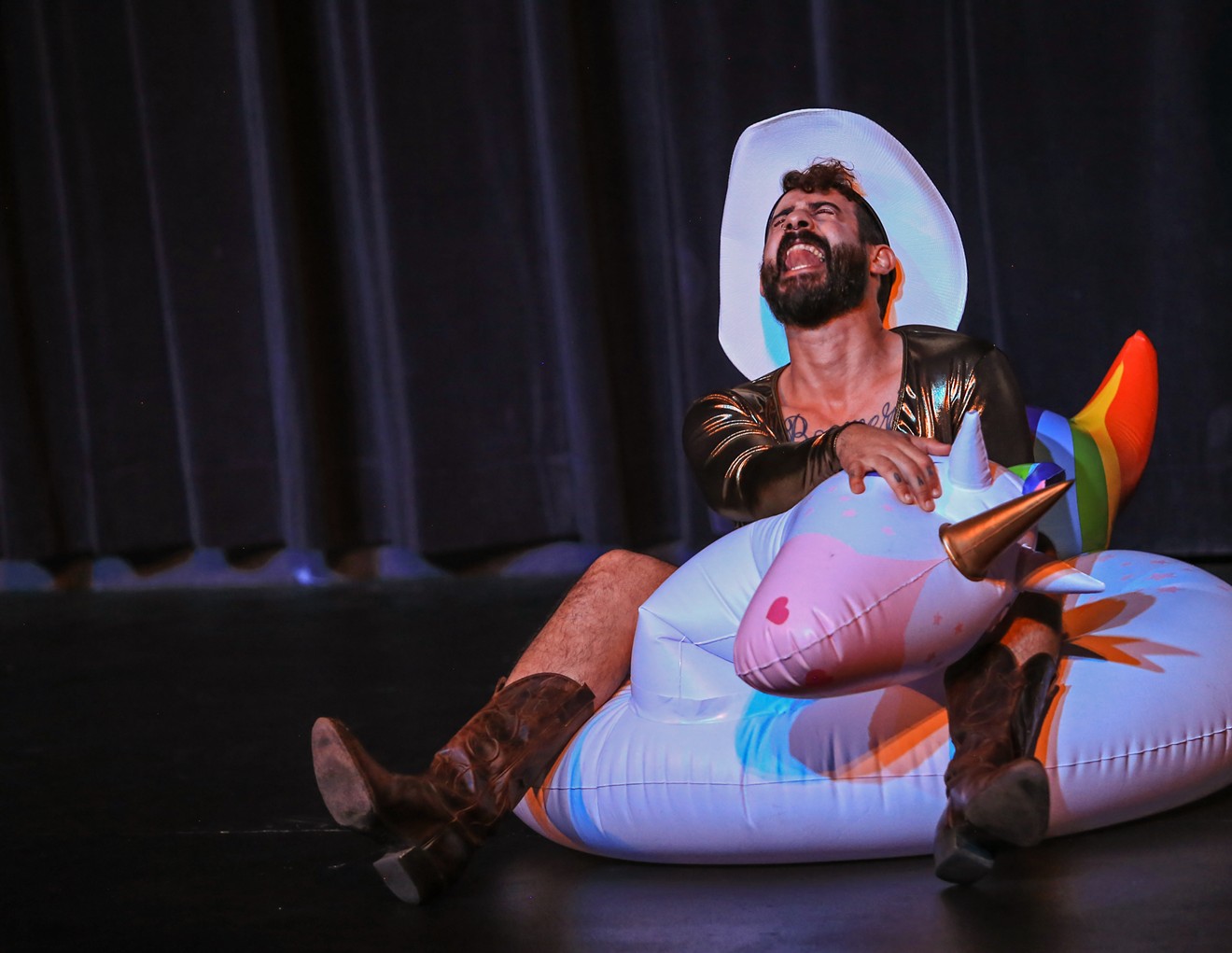Recently, hundreds of people converged on Scottsdale Center for the Performing Arts, where they celebrated the life of Frances Smith Cohen, a pioneer of the Arizona dance scene who died in May. Cohen created more than 100 works after training with modern dance maven Martha Graham, including fresh takes on classics such as Othello and The Rite of Spring.
Months before, people packed the center’s black box theater to see a vastly different style of dance. It was created by a contemporary dance company called [nueBOX], which has studio space in the Grand Avenue arts district. The lineup included a piece called Unicorn Blowjob, featuring choreographer Felix Cruz performing with a giant inflatable unicorn pool toy.
Taken together, they reveal the range of dance happening in metro Phoenix and prompt reflection on what’s next for the region’s dance scene, which has long been in flux.
“The Phoenix dance scene has made progress in the past several years,” according to Angelina Ramirez. She heads a dance company called Flamenco Por La Vida, which performs regularly inside the Crescent Ballroom lounge. “There has been more diversity in the types of people, bodies, and stories being told on stage,” Ramirez says.
Longtime staples such as Cohen’s Center Dance Ensemble and Lisa Chow’s Desert Dance Theatre are still performing. But more voices are entering the mix, and they’re taking dance into new spaces.
In February, JAMovement performed at Arizona Distilling Co. in Tempe, partnering with a local chef to present a mix of comedic dance and four-course dining. Recently, a creative duo called The Ladies brought their blend of movement, improvisational comedy, and audience participation to Changing Hands Bookstore.
Nicole Olson routinely performs original dance works in gallery and museum spaces. And Carley Conder, who founded the annual Breaking Ground contemporary dance and film festival in Tempe, has three shows lined up at Frank Lloyd Wright’s Taliesin West.
They’re all signs of more good things to come, even as Cohen’s absence continues to reverberate with the many dancers whose lives she touched through the years.
More people are seeing dance in metro Phoenix, and seeing themselves reflected in those performances. “We are seeing more black, brown, queer, gender-nonconforming, and differently shaped bodies that challenge traditional beauty norms being presented,” Ramirez says. “I think that’s a step in a much-needed direction.”
Liz Lerman, an internationally renowned choreographer who joined the ASU faculty in 2016, agrees. She has high praise for several Arizona choreographers, including Liliana Gomez and Yvonne Montoya. Gomez co-founded the Phoenix dance festival called BlakTinx, which highlights choreographers and dancers of color. Montoya is based in Tucson, but she’s garnered national attention for organizing Latinx choreographers throughout the Southwest.
There’s still room for improvement, according to Julie Akerly, who heads both [nueBOX] and JAMovement.
“There is still a lot of work to be done in terms of who has a seat at the table,” she says.
That’s not the only challenge moving forward.
“There are, of course, a handful of issues the dance community is facing regularly,” Gomez says, “including access, inclusion, audiences, affordability, pay, and many more.”
Ramirez lost her Roosevelt Row dance studio a few years ago during the area’s first wave of gentrification.
“Renting space in a variety of different locations is so challenging and expensive,” she says. Today, she’s working to open a new space on the Miracle Mile section of McDowell Road.
Sometimes, it’s a perception problem, according to Ann Ludwig, who spent decades helping to build the metro Phoenix dance scene. “People love to support local food and beer, but they act like only national dance companies have value.”
As dancers reflect on Cohen’s legacy, it’s a good time to think about what they’ll need moving forward. “We have a wonderful, growing community that needs support,” Lerman says. “Let’s raise it up so more people can see it.”
[
{
"name": "Air - MediumRectangle - Inline Content - Mobile Display Size",
"component": "18478561",
"insertPoint": "2",
"requiredCountToDisplay": "2"
},{
"name": "Editor Picks",
"component": "16759093",
"insertPoint": "4",
"requiredCountToDisplay": "1"
},{
"name": "Inline Links",
"component": "17980324",
"insertPoint": "8th",
"startingPoint": 8,
"requiredCountToDisplay": "7",
"maxInsertions": 25
},{
"name": "Air - MediumRectangle - Combo - Inline Content",
"component": "16759092",
"insertPoint": "8th",
"startingPoint": 8,
"requiredCountToDisplay": "7",
"maxInsertions": 25
},{
"name": "Inline Links",
"component": "17980324",
"insertPoint": "8th",
"startingPoint": 12,
"requiredCountToDisplay": "11",
"maxInsertions": 24
},{
"name": "Air - Leaderboard Tower - Combo - Inline Content",
"component": "16759094",
"insertPoint": "8th",
"startingPoint": 12,
"requiredCountToDisplay": "11",
"maxInsertions": 24
}
]













